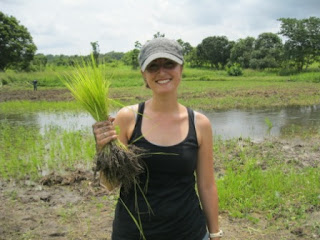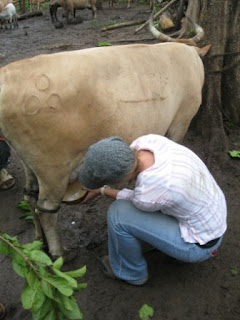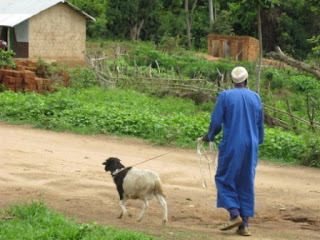“This is hard work,” Dr. Kanu said as he was showing me the calluses on his hands. We may have tractors and machinery to help in our farming, but my father made sure I knew a hard days’ work. I left the conversation a little annoyed they didn’t see me capable working in the fields, and became determined to prove I was. The following week I casually asked Dr. Sesay about his rice farm and mentioned if he needed any help, I would be willing. I was pleasantly surprised when he showed up at my office to schedule a Saturday rice farming trip.
The farm is located just north of campus tucked away in an area Lexi and have been hoping to explore. After pulling on the black rubber boots Dr. Sesay secured for us, we followed him down the path to the swamp. There are two types of rice farming in Sierra Leone: upland and swamp. Upland rice farming is common in the south and is also responsible for much of the slash and burn agriculture. Forests are cut and burned and rice is planted in its place. Usually cassava and other plants are inter-cropped, however the land can support rice for only one season and the plot can only withstand three years of other crops…then it’s off to another plot. There are mixed feelings about this system with one being that Sierra Leone has vast underutilized land with a relatively low population. The second view point (the one I support) is that slash and burn is degrading biodiversity and is not sustainable. This brings me to swamp rice. Sierra Leone has many rivers and more than sufficient rainfall for about three months out of the year. So, in the valleys farmers can cultivate a swamp and produce rice.
Dr. Sesay acquired the land a few years ago and is working on his second cropping with expanding the size. Land tenure is practically non-existent and is considered public property—as long as you are cultivating it’s yours. When you stop, someone else can move in and get to work.
Ok, back to rice farming. The sun was out in full force by the time we made it to the valley. As we came up to the water, I could see Dr. Sesay’s three nephews turning over mud and grass, termed muddling. As with all farming in Sierra Leone, swamp rice is labor intensive. The land is first plowed via tractor (rented) or human power. Using something like a hoe, the men turn the soil (muddling) allowing the lowland to flood. Small rice plants are then transplanted from the nearby nursery and placed in the mud below the water’s surface. I’m honestly not sure what happens next…other than that is should grow!
To get to where the barefooted guys were working we had to cross the swamp…through water that hit just below the tops of my boots and navigating around the mud that acts as super glue to rubber boots. Quite the challenge! Since we came to do some work, Dr. Sesay gave us a job: transplanting rice. There are distinct gender roles in just about every aspect of life here, and rice farming is no different. Men work the ground and women usually plant and weed. He brought Lexi and each a small bundle of rice plants and instructed us to take no more than two and press the roots into the mud putting about 8 inches between each. It was fun to get dirty…once I got over the fact that I was sticking my precious hand into grimy water that produced a snake about 20 minutes earlier. I was the last to finish between Dr. Sesay, Lexi and myself, but it was because I transplant rice with the care and attention each plant deserves.
Then, it was on to plucking plants from the nursery which is a small, densely populated group of rice planted on the shore of the swamp (on the other side, of course). To do this, you just grab a handful of plants, pull them up near the roots and then use the toe of your boot to bash off the mud and dirt…leaving nearly clean roots. By the end of our time, I got better at not flinging mud on my face…something the other two never had a problem with. I would have like to stay longer than the 3 hours we spent wading in the swamp, but it was time to go…
Rice is the number one staple, but the country relies on imports from Asia to meet the demand as acre after acre remains unused. Many suffer from hunger during the off seasons. Dr. Sesay mentioned that farming is considered “poor man’s job,” but the university is working to change that viewpoint…leading by example. Educated men investing back into agriculture can only move the country forward to becoming more food secure.
Joyful Journeys,
Julie
PS: I’m a little nervous our plot planted by the pumuys won’t grow…so I often check up with Dr. Sesay who reassures me that the rice is doing fine. We are working out a second visit.

Dr. Sesay at the swamp, with his hard working nephews.
 This a nursery at the swamp farm near Dr. Sesay's. The small hut in the back is typical of both upland and swamp rice. Those working will use it a temporary shelter during the day.
This a nursery at the swamp farm near Dr. Sesay's. The small hut in the back is typical of both upland and swamp rice. Those working will use it a temporary shelter during the day. Inter-cropping: rice, cassava and maize.
Inter-cropping: rice, cassava and maize.
 The swamp.
The swamp. Here you can see the contrast between the swamp with rice and the mud that still needs to be turned.
Here you can see the contrast between the swamp with rice and the mud that still needs to be turned.

































































